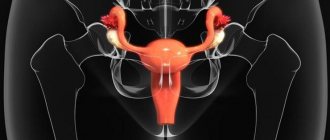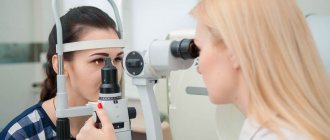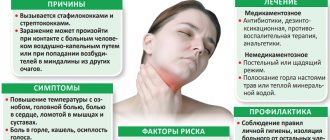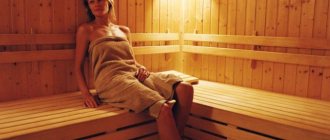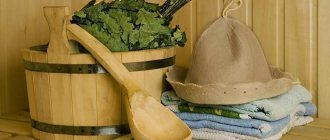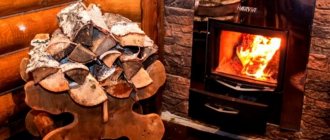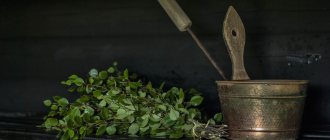Among respiratory diseases, bronchial asthma occupies a special place. The disease occurs in a chronic form and is periodically accompanied by coughing attacks, which can be triggered by various factors. Asthmatics are forced to take medications throughout their lives, adhere to a special diet and lead a certain lifestyle.
Dry or humid hot air has different effects on the condition of the bronchi, while the immune system receives a strong shake-up and activates hidden reserves. Experts agree that going to the bathhouse for asthma is safe during the period of remission, following the sequence of all stages of the thermal procedure and gradually accustoming the body to the load.
Bathhouse for adults
Unlike children, adults have stronger immunity and resistance to negative factors. An asthmatic can theoretically go to the bathhouse, but it all depends on what stage his illness is at.
Asthma, which is steadily controlled, allows you to go to the bathhouse and even enter the steam room, but the patient must be sure that the essential oils that are released when the wood is heated will not harm him. Often baths, steam rooms, and saunas are built from coniferous wood. It could be pine, larch or even cedar. In this case, a certain amount of essential oils is released into the air, which can cause an attack in a person sensitive to odors.
If your doctor does not recommend going to the bathhouse, you should definitely follow his advice. Asthma is a rather serious disease that must be taken into account. Failure to follow the doctor's recommendations can lead to a serious condition in which inhalers become powerless. In this case, there is a threat to life.
What is asthma
First of all, let's find out what bronchial asthma is. This is usually a chronic disease of the respiratory tract, which is accompanied by the occurrence of attacks in unfavorable situations. Typically, attacks occur spontaneously when an allergen enters the body of a person with this disease. There are several most common causes of severe suffocation:
- inhalation of house dust;
- eating foods high in protein;
- inhalation of plant pollen;
- inhalation of harmful fumes when working with hazardous materials;
- stressful situations and intense physical activity.
This is an incomplete list; in fact, there are many more reasons, and, as a rule, a person with the disease knows what exactly causes his attacks.
How can you suspect COPD?
The first signs of chronic obstructive pulmonary disease may be a prolonged cough with sputum, shortness of breath, wheezing and a feeling of heaviness in the chest. These symptoms can indicate anything, so you should consult a specialist as soon as possible and undergo spirometry and other tests.
Konstantin Mokanov: Master of Pharmacy and professional medical translator
Related publications
Modern infrared sauna: the benefits and harms of a fashionable “bath”
Seven popular public saunas in Helsinki
Six Finnish sauna traditions that surprised US residents
The findings were published in the November 2020 issue of the scientific journal Respiratory Medicine, and previously in the European Journal of Epidemiology in September 2020. They are some of the latest official scientific data obtained as a result of many years of research on the effect of saunas on human health. And the research results undoubtedly inspire confidence and add positivity to all sauna fans.
Myth #4: You shouldn’t exercise if you have COPD.
Truth: Moderate exercise won't harm your lungs. In fact, they may even relieve COPD symptoms, increase stamina, strengthen your heart, and reduce stress levels.
If you find that shortness of breath makes it difficult to exercise, there are special comprehensive treatment programs called pulmonary rehabilitation. They are aimed at teaching patients proper breathing techniques, physical therapy and the basics of rational nutrition for COPD.
For such problems, you need to devote at least 20-30 minutes to physical therapy at least 3-4 times a week. Combine a safe cardio warm-up with stretching and strength-building exercises. Be sure to consult your doctor before taking a new complex. Rest before and after exercise, starting no earlier than 1.5 hours after eating.
Treatment of pathology using bath procedures
If you intend to treat bronchial asthma with a bath, you should consider some recommendations:
- Even before visiting the bathhouse, begin to gradually get used to hot procedures. Soak your feet in a basin of hot water, gradually lengthening the time, and only then go to the bathhouse.
- The temperature in the steam room should not exceed 90ºC.
- Don’t look at other people; your stay in the steam room should not exceed 5 minutes at first. Go to the dressing room, but under no circumstances douse yourself with cold water. A sharp temperature contrast can provoke an attack of suffocation. Then return to the steam room again.
- The total time spent in the steam room should not exceed 25-30 minutes. If you tolerate this procedure well, you will subsequently be able to consistently increase the time of your bath visit.
- Do not use a broom made from plants that cause allergies in your steam room. This applies not only to you, but also to those who came with you. In the steam room, use only one type of broom to find out how your body reacts to it. Next time, use something else. This way you will understand whether you are allergic to this plant or not.
- If you do inhalations with eucalyptus, chamomile or coltsfoot at home, try using these herbs in the steam room. It is possible that this will have a positive effect.
- Just in case, take your Berotek or Ventolin inhaler to the bathhouse; this will help avoid unpleasant consequences in the event of a sudden attack. A more effective measure would be an intravenous injection of Eufillin or a subcutaneous injection of ephedrine hydrochloride or adrenaline hydrochloride. The main thing is to find a person who knows how to give such injections in time.
A patient with bronchial asthma is at great risk in a bathhouse, because he will not be able to tolerate humid heat like healthy people.
However, if you are careful, there is a chance that with systematic treatments you will overcome the disease.
Sauna in the rehabilitation of respiratory patients
annotation
The effectiveness of using a sauna in the complex treatment of pulmonary pathology has been shown. The optimal time spent in the sauna has been determined. Different degrees of thermoregulation have been revealed depending on the disease. Data on indicators of external respiration function before and after treatment in the sauna are presented.
Keywords:
bronchospasm, auxiliary respiratory muscles, sauna.
Global environmental pollution, which contributes to the continuous intake of toxic sensitizing substances into the body (environmental causes), bad habits, social cataclysms, unresolved states of distress, nutritional defects, drug overload, as well as unfavorable professional characteristics affect the human body, disrupting cellular metabolism, system homeostasis, that is, its internal ecology - endoecology [2,3,5]. Under the current conditions, the organism's evolutionary inability to resist the aggression of anthropogenically caused environmental factors was revealed. Of particular importance in this case is the duration of exposure to small doses of incoming metabolites, which are capable of entering into chemical bonds and causing inadequate responses of the body [3]. Polypharmacy in the treatment of respiratory diseases, in particular obstructive pulmonary disease (COPD), aggravates the intoxication of the patient's body.
Taking into account the above, one of the pressing problems of our time is the study of the characteristics of contamination of the human body and ways of its detoxification. A group of scientists led by Professor Yu.M. Levin (1969-1995) showed that the main place of accumulation of toxins in the body (more than 80%) is the extravascular tissue surrounding the cells - the interstitium. Under conditions of progressive contamination of the body, toxic substances accumulate in the interstitial space and enter into chemical reactions with each other, which contributes to the emergence of new poisons. Ultimately, this leads to the fact that the eco-space of the cell becomes oversaturated with exo- and endotoxins, and it has to function in extremely unfavorable conditions. [3,5]. In conditions of an environmental crisis, the body’s self-cleaning ability turned out to be unable to cope with the massive attack of toxic substances [4,5]
For these reasons, the sauna is indicated for the treatment of respiratory diseases, in particular CNB, COPD. Let us recall that at a temperature of 70C the rheological properties of biological fluids improve [1,10]. The temperature factor can serve as a prevention of bronchospasm. Raising the temperature above 40 degrees blocks passive sensitization. Warming prevents the development of an anaphylactic reaction between the antigen and the antibody and the release of histamine [8].
In these cases, it has a complex effect on local inflammation of the mucous membrane, discrinia, and bronchospasm [9,13,14,15]. In the literature studied, there is no substantiated data on the duration of stay in the sauna for this category of patients and the degree of sweating. The author is the first to give the time characteristics of sweating of various nosological forms of bronchopulmonary pathology. To determine the optimal time spent in a sauna to prevent heat stroke, the author studied the intensity of sweating in 76 patients with chronic disease (35 men and 41 women) aged from 17 to 55 years with a disease duration of 2 to 15 years. The control group consisted of 21 people (10 men, 11 women), athletes and athletes aged from 15 to 57 years. In healthy individuals, sweating ends in the second minute. Comfortable sensations last up to the fifth minute of being in the sauna.
Studies have shown that the initial indicators of skin moisture in those suffering from chronic disease are slightly higher than in healthy people (Tables 1 and 4). The intensity of sweating in the control group (healthy) ended in the second minute.
Table 1 - Dynamics of the sweating intensity coefficient in the sauna (M±m) (men)
| Disease | I approach | II approach | ||||||||
| original | 1′ | 2′ | 3′ | 4′ | original | 1′ | 2′ | 3′ | 4′ | |
| Control | 56,0±4,9 | 31,0±5,0 | 13,0±3,1 | 34,0±2,5 | 18,6±3,5 | 5,7±1,6 | ||||
| 39,0±4,3 | 21,0±6,1 | 2,9±1,7 | 26,0±4,4 | 5,7±1,8 | ||||||
| HNB | 62,0±4,2 | 30,0±3,5 | 11,0±1,9 | 1,5±0,5 | 30,0±3,9 | 12,0±2,5 | 2,8±1,0 | |||
| 51,0±3,4 | 20,0±2,3 | 3,6±1,3 | 0,1±0,09 | 18,0±2,3 | 2,6±1,3 | 0,3±0,1 | ||||
| COPD | 69,0±5,6 | 36,0±6,4 | 12,4±4,6 | 3,0±1,8 | 0,8±0,1 | 29,0±4,8 | 11,0±2,8 | 2,8±1,1 | ||
| 56,3±5,7 | 23,0±5,5 | 5,7±2,7 | 1,3±0,9 | 0,3±0,2 | 17,0±4,3 | 4,1±2,0 | 0,4±0,3 | |||
Table 2 - Dynamics of the sweating intensity coefficient in the sauna (M±m) (women)
| Disease | I approach | II approach | ||||||||
| original | 1′ | 2′ | 3′ | 4′ | original | 1′ | 2′ | 3′ | 4′ | |
| Control | 62,0±3,7 | 40,0±4,0 | 11,0±1,3 | — | — | 48,0±3,8 | 19,6±3,4 | 2,5±0,2 | — | — |
| 58,0±3,9 | 21,0±2,8 | 2,1±0,6 | — | — | 35,0±3,5 | 7,5±1,4 | 0,35±0,3 | — | — | |
| HNB | 63,0±5,5 | 38,0±7,8 | 8,5±3,6 | 1,3±0,8 | 0 | 38,0±7,0 | 15,5±4,5 | 2,2±1,2 | — | — |
| 60,0±5,3 | 24,0±6,6 | 6,0±2,4 | 0,7±0,6 | — | 29,0±5,2 | 7,7±2,5 | 2,3±1,0 | 0,09±0,0 3 | — | |
| COPD | 65,0±6,4 | 30,0±5,3 | 7,6±3,0 | 2,0±1,0 | 11,0±4,9 | 36,0±4,9 | 12,0±3,0 | 3,6±1,7 | 0,9±0,3 | 0,3±0,2 |
| 62,0±5,9 | 24,0±5,2 | 7,3±2,6 | 4,3±1,7 | 2,3±1,0 | 25,0±4,6 | 9,0±2,4 | 3,4±1,4 | 1,0±0,6 | 0,2±0,1 | |
In patients with CB, sweating continued later: in those suffering from CNB - up to the second and third minutes, in COPD - until the fourth minute.
Consequently, adaptation to thermal stress in this group of respiratory patients is significantly reduced. This may cause exacerbation of the inflammatory process. It should be noted that men quickly adapt to the heat load during their second visit to the sauna. Observation shows that visiting a sauna every other day increases the degree of sweating in both men and women, that is, there is a training effect of thermal stress. It should be noted that in men with chronic non-obstructive bronchitis (CNB), in the 2nd visit to the sauna, the initial sweating data become less than in the 1st visit. In women suffering from CNB, the same clinical picture is observed. But in women, sweating is observed even during the 2nd visit to the sauna, while in men it has already stopped. This probably indicates a greater adaptability of the female body to overheating and a tendency to self-cleanse the body of exo- and endotoxins.
The initial moisture content of the skin of men suffering from chronic obstructive pulmonary disease (COPD) is significantly higher than that of persons suffering from chronic non-obstructive bronchitis (CNB). It can be concluded that a greater severity of the disease is accompanied by greater moisture in the skin. By the 13th session of treatment in the sauna, the initial moisture content of the skin of patients with COPD is practically comparable with the moisture content of the skin of patients suffering from CNB. This can be assumed to be a positive prognostic indicator of the rehabilitation effect of the sauna for this pathology. COPD is accompanied by a longer sweating time than those with CNB. This applies to both men and women. A peculiarity of the female body is that sweating in women suffering from COPD lasts longer (4 minutes) than in men (2 minutes) during the 2nd visit to the sauna. Consequently, the endoecological environment of women is better freed from toxins than that of men.
The initial indicators of skin moisture in women suffering from COPD are also higher than in women suffering from CNB. However, as the course of treatment continues, the moisture level of the skin becomes equal in people suffering from COPD and CNB. From observations it is clear that the duration of sweating in patients with COPD is significantly longer than in those suffering from CNB in the second visit to the sauna. The intensity of sweating in women with COPD is also significantly higher than in women with CNB. There is also a parallel between the severity of the painful condition and the degree of sweating intensity. The convergence of sweating coefficients by the seventh sauna session (13th day of treatment) indicates a positive rehabilitation effect of thermal stress.
As a result of exposure to the sauna during the course of treatment (7 procedures), the change in the patients’ body weight is more pronounced in the first days of treatment, then adaptation to the thermal load occurs and the body weight stabilizes.
The average weight loss in patients with COPD as a result of exposure to the sauna (in g) was 1043 ± 17 g (in men) and 963 ± 15 in women in patients with COPD. Men suffering from CNB lost weight - 865±17 g and, accordingly, 1003±21 g - women.
The cardiovascular system of patients with CNB and COPD responds to thermal exposure to a sauna (for 5 minutes) with a normotensive reaction. There are no negative electrocardiographic signs. Up to 1600 ml of viscous mucopurulent sputum was discharged during the course of treatment. Thus, the optimal time for staying in the sauna was determined - 5 minutes each for two visits (temperature 110°C) for patients with CNB and COPD. The positive dynamics of external respiration function indicators from the effects of the sauna indicates an improvement in the function of the respiratory system (Tables 3,4).
Table 3 - Dynamics of indicators of external respiration function during treatment in the sauna
for patients with COPD (men) (M±w)
| Indicators | SAME | FJE | FEO 1.0 | FEO 2.0 | FEO PED | PED | MED 25 | MED 50 | MED 75 | MED 200-1200 |
| Before treatment | 57b±10 | 39.6±10.3 | 43.1±2.8 | 1.8 ±0.28 | 0.17±0.03 | 39.7±7.2 | 21.0±2.9 | 13.7±2.6 | 15.7+1 .□ | 20.6±3.1 |
| After treatment | 101±11 | 97.4±12.3 | 58.7±7.2 | 2.8±0.37 | 0.29±0.04 | 59.6±6.6 | 29.Sh.9 | 22.2±3.2 | 18.4±0.72 | 39.9±7.4 |
| t | 2.92 | 2.36 | 2.02 | 2.16 | 2.4 | 2.04 | 2.34 | 2.06 | 2.19 | 2.13 |
| Indicators | MED 25-75 | MED 75-85 | At 25-75 | At 75-85 | In PED | In FJE | FEO 1.0 SAME | FEO 1.0 FJE | FEO 2.0 FJE | FEO PED FJE |
| Before treatment | 15.1±3.4 | 38±1 | 2.2±0.062 | 1.1 ±0.25 | 0.19±0.016 | 3.2 ±0.2 | 42.7±0.62 | 47.7±0.6 | 74.9±1.1 | 7.1 ±0.28 |
| After treatment | 24.3±2.8 | 35±0.56 | 2±0.063 | 1.8 ±0.2 | 0.15:±0.01 | 3.8 ±0.21 | 43.9±1.4 | 49.4±0.4 | 72.6±0.15 | 6.3 ±0.18 |
| t | 2.09 | 2.16 | 2.23 | 2.19 | 2.12 | 2.07 | 2.09 | 2.36 | 2.07 | 2.40 |
Table 4 - Dynamics of indicators of external respiration function during treatment in the sauna for patients with COPD (women) (M±w)
| Indicators | SAME | FJE | FEO 1.0 | FEO 2.0 | FEO PED | PED | MED 25 | MED 50 | MED 75 | MED 200-1200 |
| Before treatment | 37.3±3.6 | 33.8±3.4 | 43.3±3 | 1.3 ±0.16 | 0.14±0.01 | 33±3.2 | 31.0+1.2 | 18.7±0.21 | 20.4±2.0 | 19.8±2.0 |
| After treatment | 73.3±3.4 | 67.6±4.8 | 33.2±3.3 | 1.7+0.1 | 0.19±0.02 | 69.3±4.6 | 34.0±0.8 | 17.9±0.27 | 15.0+1.6 | 25.9±1.9 |
| t | 2.06 | 2.01 | 2.13 | 2.12 | 2.24 | 2.06 | 2.08 | 2.34 | 2.11 | 2.21 |
| Indicators | MED 25-75 | MED 75-85 | At 25-75 | At 75-85 | In PED | In FJE | FEO 1.0 SAME | FEO 1.0 FJE | FEO 2.0 FJE | FEO PED FJE |
| Before treatment | 23.6±1.13 | 41.7±6.6 | 1.13±0.18 | 0.7±0.08 | 0.09±0.007 | 3.1 ±0.46 | 63.3±2.3 | 60.7±0.8 | 70.3±1.31 | 8.3±0.11 |
| After treatment | 20.1+1.2 | 25.5±4.3 | 1.9 ±0.31 | 1.3 ±0.28 | 0.11±0.006 | 5.4±0.89 | 5b.5±2.1 | 38.7±0.5 | 74.3±0.73 | 8.7±0.13 |
| t | 2.11 | 2.03 | 2.09 | 2.06 | 2.17 | 2.30 | 2.14 | 2.12 | 2.37 | 2.13 |
CONCLUSIONS
- The sauna is the most important factor in ensuring favorable endoecology of the body of a respiratory patient.
- The positive dynamics of external respiration function indicators indicates the effectiveness of the use of a sauna in the complex rehabilitation of respiratory pathology.
- The optimal time spent in the sauna was determined for chronic non-obstructive bronchitis and chronic obstructive pulmonary disease.
LITERATURE
- Vanchikov, V.Ts. Friction layer control in technological processes / V.Ts. Vanchikov. - Irkutsk: [b.i.], 2006. - 168 p.
- Kosyakova, N.I. Endoecology - human ecology in the environment // Man and the Environment: abstract. report - M., 1994. - P. 72.
- Kaznacheev, V.P. Endoecology from space to cell // Problem of clinical lymphology and endoecology: First Russian. conf. with international participation. - M., Sochi, 1997. - P. 9-14.
- Krasnova, Yu. N. Chronic obstructive pulmonary disease: yesterday, today, tomorrow: monograph / Yu.N. Krasnova; State in-and improvement of doctors. - Irkutsk: [b.i.], 2008. - 204 p.
- Levin, Yu.M. Problems of endoecology // Doctor. - 1994. - No. 5. - P. 51.
- Lunichkina, I.A. The influence of general therapeutic hyperthermia in a sauna on indicators of blood homeostasis in patients with chronic bronchitis / I.A. Luchinina, S.V. Tyutyunnikov // New methods of diagnosis and rehabilitation of patients with nonspecific lung diseases: abstract. Rep. conf. - M., Barnaul, 1985. - T. 2. - P. 125-127.
- Matveykov, G.P. Use of dry-air sauna for bronchospastic syndrome / G.P. Matveikov, V.K. Milkamanovich, T.M. Tserakh // Healthcare of Belarus. - 1984. - No. 1. - P. 61-63.
- Rheology / ed. Eirikha R.M. - M.: Publishing House Foreign. lit., 1962. - 824 p.
- Strashinina, O.A. Rheological properties of sputum and methods for their study // Bronchial contents in chronic bronchitis. - L., 1981. - P. 30-35.
- Kholmogorov, I.V. Thermodynamic condition for the occurrence of capillary obliteration / I.V. Kholmogorov, G.K. Khomyakov, V.Ts. Vanchikov // Bulletin of mechanical engineering. - 2008. - No. 12. - P. 20-22.
- Khomyakov, G.K. Control of the obliteration process in the tracheobronchial system / G.K. Khomyakov, V.Ts. Vanchikov // Information systems for control and management in industry and transport. Modeling. Control systems. -Irkutsk, 2006. - Issue. 15. - pp. 64 -66.
- Koberle, G. Die Sauna ala Basisbehandlung beim Asthna-bronchiale // Sauna-Archiv. — l968. - No. 6. - S. 18-20.
- Matej, M. Blutgase und azidobasisches Gleigewicht bei gesunden Mannern nach fi-nischer Sauna / M. Matej, V. Sincak // Z. Angew. Bader, Klimaheilkunde. - 1977. - No. 24. - S. 24-30.
Contact Information:
Effective folk remedies
However, one of the most effective preparations is mustard-honey cake.
This compress is prepared as follows:
- prepare a homogeneous mixture from mustard, flour, vegetable oil and honey, taken in equal quantities;
- put the resulting mass in a hot oven for a few minutes (3-5) - the mixture will turn brown;
- Divide the mass in half, place one half of the honey cake on your back, the other on your chest;
- wrap the patient in a sheet, a warm blanket and let him rest (it is better to do this at night);
- after the cake has done its job, it should be removed from the skin, and the places where it was located should be wiped with a damp cloth.
The effect of this procedure will be noticeable after 3-5 days: coughing attacks will become less frequent, sputum will be cleared better, and your health will improve significantly.
It is necessary to start treating bronchitis with traditional methods only after consulting with your doctor.
Possible consequences
Feeling unwell, difficulty breathing, and the appearance of wheezing in the bathhouse can easily be overlooked or tried to be explained by exposure to unusual conditions, so it is important to make sure that there are no warning symptoms before starting a course of thermal effects. Bronchial asthma and a bath are compatible concepts with a reasonable approach. Asthmatics can lead a normal life and are practically no different from healthy people only if they receive timely medical supervision and control.
Myth #3: If you have COPD, it's too late to quit cigarettes.
Truth: It's actually never too late to quit smoking because once you do, you have a real chance of slowing the progression of the disease. The sooner this happens, the more your doctor can do for you in the future.
“Unfortunately, with COPD, damage gradually accumulates in the lungs. Therefore, you must understand that the disease will not disappear on its own. But we are able to slow its progression and maintain adequate lung function for as long as possible,” says Nikolasakis.
If you cannot overcome a bad habit on your own, then use one of the many options for addiction treatment - nicotine patch or chewing gum, sessions with a psychotherapist, support groups, etc.
Myth #3: If you have COPD, it's too late to quit cigarettes.
Truth: It's actually never too late to quit smoking because once you do, you have a real chance of slowing the progression of the disease. The sooner this happens, the more your doctor can do for you in the future.
“Unfortunately, with COPD, damage gradually accumulates in the lungs. Therefore, you must understand that the disease will not disappear on its own. But we are able to slow its progression and maintain adequate lung function for as long as possible,” says Nikolasakis.
If you cannot overcome a bad habit on your own, then use one of the many options for addiction treatment - nicotine patch or chewing gum, sessions with a psychotherapist, support groups, etc.
Myth #4: You shouldn’t exercise if you have COPD.
Truth: Moderate exercise won't harm your lungs. In fact, they may even relieve COPD symptoms, increase stamina, strengthen your heart, and reduce stress levels.
If you find that shortness of breath makes it difficult to exercise, there are special comprehensive treatment programs called pulmonary rehabilitation. They are aimed at teaching patients proper breathing techniques, physical therapy and the basics of rational nutrition for COPD.
For such problems, you need to devote at least 20-30 minutes to physical therapy at least 3-4 times a week. Combine a safe cardio warm-up with stretching and strength-building exercises. Be sure to consult your doctor before taking a new complex. Rest before and after exercise, starting no earlier than 1.5 hours after eating.
